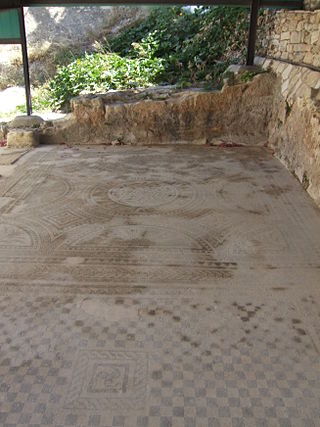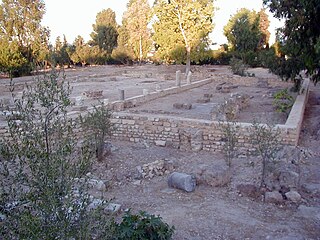Related Research Articles
A bishop is an ordained member of the clergy who is entrusted with a position of authority and oversight in a religious institution. In Christianity, bishops are normally responsible for the governance and administration of dioceses. The role or office of the bishop is called episcopacy. Organizationally, several Christian denominations utilize ecclesiastical structures that call for the position of bishops, while other denominations have dispensed with this office, seeing it as a symbol of power. Bishops have also exercised political authority within their dioceses.

An episcopal polity is a hierarchical form of church governance in which the chief local authorities are called bishops. The word "bishop" here is derived via the British Latin and Vulgar Latin term *ebiscopus/*biscopus, from the Ancient Greek ἐπίσκοπος epískopos meaning "overseer". It is the structure used by many of the major Christian Churches and denominations, such as the Catholic, Eastern Orthodox, Oriental Orthodox, Church of the East, Anabaptist, Lutheran, and Anglican churches or denominations, and other churches founded independently from these lineages. Many Methodist denominations have a form of episcopal polity known as connexionalism.

In church governance, a diocese or bishopric is the ecclesiastical district under the jurisdiction of a bishop.
An ecclesiastical province is one of the basic forms of jurisdiction in Christian churches, including those of both Western Christianity and Eastern Christianity, that have traditional hierarchical structures. An ecclesiastical province consists of several dioceses, one of them being the archdiocese, headed by a metropolitan bishop or archbishop who has ecclesiastical jurisdiction over all other bishops of the province.

Britonia is the name of a Romano-British settlement on the northern coast of the Iberian peninsula at the time of the Anglo-Saxon invasion of Britain. The area is roughly that of the northern parts of the modern provinces of A Coruña and Lugo in the autonomous community of Galicia, Spain.

Telmessos or Telmessus, also Telmissus, later Anastasiopolis, then Makri or Macre, was the largest city in Lycia, near the Carian border, and is sometimes confused with Telmessos in Caria. It was called Telebehi in the Lycian language. The well-protected harbor of Telmessos is separated from the Gulf of Telmessos by an island.

Lyrbe was an ancient city and later episcopal see in the Roman province of Pamphylia Prima and is now a titular see.

Hypaepa or Hypaipa was an Ancient city and (arch)bishopric in ancient Lydia, near the north bank of the Cayster River, and 42 miles from Ephesus, Ephesus and remains a Latin Catholic titular see.
Harpasa was a city and bishopric in ancient Caria in Roman Asia Minor, which only remains a Latin Catholic titular see.

In the Catholic Church, a bishop is an ordained minister who holds the fullness of the sacrament of holy orders and is responsible for teaching doctrine, governing Catholics in his jurisdiction, sanctifying the world and representing the Church. Catholics trace the origins of the office of bishop to the apostles, who it is believed were endowed with a special charism and office by the Holy Spirit at Pentecost. Catholics believe this special charism and office has been transmitted through an unbroken succession of bishops by the laying on of hands in the sacrament of holy orders.
The appointment of bishops in the Catholic Church is a complicated process. Outgoing bishops, neighbouring bishops, the faithful, the apostolic nuncio, various members of the Roman Curia, and the pope all have a role in the selection. The exact process varies based upon a number of factors, including whether the bishop is from the Latin Church or one of the Eastern Catholic Churches, the geographic location of the diocese, what office the candidate is being chosen to fill, and whether the candidate has previously been ordained to the episcopate.

Argyroupoli is a village in the municipality of Rethymno, Rethymno regional unit, Crete, Greece, with a population of 313 and an altitude of 260 m. It was previously known as Lappa or Lampa, Stimboli, and Polis.
The Archbishop of Dublin is the head of the Archdiocese of Dublin in the Catholic Church, responsible for its spiritual and administrative needs. The office has existed since 1152, in succession to a regular bishopric since 1028. The archdiocese is the metropolitan see of the ecclesiastical province of Dublin, and the archbishop is also styled the Primate of Ireland. The cathedral church of the archdiocese is Saint Mary's Pro-Cathedral in Dublin city, although the Church formally claims Christ Church as its cathedral, and the archbishop's residence is Archbishop's House in Drumcondra.
Arabissus or Arabissos, also known as Tripotamos, was a town in ancient Cataonia, then Cappadocia, and later in the Roman province of Armenia Secunda.
Drizipara, also known as Druzipara, Drousipara, Drusipara; now Büyükkarıştıran/Büyükkarıştıran' in Lüleburgaz district, was a city and a residential episcopal see in the Roman province of Europa in the civil diocese of Thrace. It is now a titular see of the Catholic Church.
Claudiopolis was an ancient city in the Roman province of Paphlagonia in northern Asia Minor.
Traianopolis, Trajanopolis, Tranopolis, or Tranupolis was a Roman and Byzantine city in Phrygia Pacatiana Prima.

The Archdiocese of Carthage, also known as the Church of Carthage, was a Latin Catholic diocese established in Carthage, Roman Empire, in the 2nd century. Agrippin was the first named bishop, around 230 AD. The temporal importance of the city of Carthage in the Roman Empire had previously been restored by Julius Caesar and Augustus. When Christianity became firmly established around the Roman province of Africa Proconsulare, Carthage became its natural ecclesiastical seat. Carthage subsequently exercised informal primacy as an archdiocese, being the most important center of Christianity in the whole of Roman Africa, corresponding to most of today's Mediterranean coast and inland of Northern Africa. As such, it enjoyed honorary title of patriarch as well as primate of Africa: Pope Leo I confirmed the primacy of the bishop of Carthage in 446: "Indeed, after the Roman Bishop, the leading Bishop and metropolitan for all Africa is the Bishop of Carthage."
Meloë was a town in ancient Lycia, located near Cape Kilidonia.
Lappa was an ancient city in Crete. It was located near modern Argyroupoli.
References
- 1 2 Herbermann, Charles, ed. (1913). . Catholic Encyclopedia . New York: Robert Appleton Company.
- ↑ Annuario Pontificio 2013 (Libreria Editrice Vaticana 2013 ISBN 978-88-209-9070-1), "Sedi titolari", p. 913
- ↑ The Hierarchy of the Catholic Church, s.v. Lappa